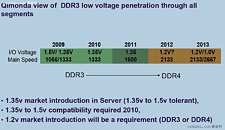Sunday, August 24th 2008
DDR3 to DDR4 Transition Chalked-out, DDR4 in 2012
The transition between PC memory standards has always relied on changes in PC platforms for effectiveness. For example, the LGA 775 saw transition between two standards, the i915 MCH supported DDR and DDR2 memory, i925 onwards it became mandatory for people to use DDR2 memory as the platform required it. In came DDR3 and it became optional for users to choose it over DDR2. Even now, there is only a gradual transit between DDR2 and DDR3. With Nehalem however, it will become mandatory to use DDR3 memory, both with the LGA 1366 and LGA 1160 socket motherboards in either two or three channel configurations.
Qimonda has already chalked out plans for a smooth transition to DDR4 PC memory. According to Qimonda's development plan, DDR4 would be out by 2012. The memory standard will operate at (DDR) frequencies as high as 2,133 MHz at an approximate voltage of 1.2 V and by 2013, we could be seeing 2,667 MHz memory at 1.0 V, a phase during which there's a transition between the current DDR3 and future DDR4 PC memory standards.
Source:
Hardspell
Qimonda has already chalked out plans for a smooth transition to DDR4 PC memory. According to Qimonda's development plan, DDR4 would be out by 2012. The memory standard will operate at (DDR) frequencies as high as 2,133 MHz at an approximate voltage of 1.2 V and by 2013, we could be seeing 2,667 MHz memory at 1.0 V, a phase during which there's a transition between the current DDR3 and future DDR4 PC memory standards.

36 Comments on DDR3 to DDR4 Transition Chalked-out, DDR4 in 2012
Mhz CL ns/cycle total time (ns)
100 2 10 20
133 3 7.5 22.5
333 2.5 3 7.5
400 3 2.5 7.5
800 5 1.25 6.25
As the mhz increases the CL may increase however the actual time it takes still decreases. So even if we're at CL 10 @DDR3 1600 its timing is still as tight as ddr2 with cl5.
It's not cost effective for a while, I guess is what I'm getting at.
:x
Though, IGPs are gonna love it...
for anyone that wants proof as to DDR3 timings vs latency:
you'll find those results are on par with a lot of DDR2 clocked at lower speeds with tighter timings, and I'm only running upper-mid range sticks . . . not the "super clocker" top-tier sticks on the market.
DDR3 can go much higher, and timings can be tightened down a lot more, but you'll have to start worrying about DRAM cooling, though. There's still a lot of potential with DDR3.
As to the DDR4 . . . nice to know when for sure it'll be coming . . . :D
LoL, sorry no one else had done it yet ; )
I'm suprised they are putting DDR4 that far out. With so much hype with DDR5 on GPUs.
although, I still rest by my earlier example and bench that I posted showing that solid mid-range DDR3 can tangle with some of the best DDR2 offerings. Yeah, I've seen DDR2 pull some better read/write latencies at lower clock settings; but considering my timings, and the very, very mild OC (1600-stock vs 1800-OC), there's still a fathom of potential left.
Now, I just need to go liquid cooling so I can start fiddling further with 4GHz+ CPU clocks :Dwell . . . technically, there are slight differences between SYS DRAM and GPU DRAM. it's nothing dramatic, really, but the differences equate to GDRAM being developed for use and access by GPUs; they respond faster, tend to be more efficient and are capable of running at much faster speeds than their equivalent SYS DRAM components. The biggest difference between the two varieties, is that GDDR# can turn on a MEM bank and read from it within the same clock cycle, whereas SYS DDR# can't.
Otherwise GDDR# operates at a theorhetical level the same as DDR#.